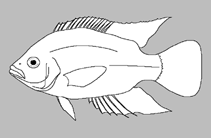Upload your photos and videos
Pictures | Google imageNo image available for this species;
drawing shows typical species in Cichlidae.
Pictures | Google imageNo image available for this species;
drawing shows typical species in Cichlidae.
Common names from other countries
Classification / Names Common names | Synonyms | Catalog of Fishes(genus, species) | ITIS | CoL | WoRMS | Cloffa
Teleostei (teleosts) > Cichliformes (Cichlids, convict blennies) > Cichlidae (Cichlids) > Pseudocrenilabrinae
Etymology: kumwera: The name kumwera means 'south' in Chichewa, alluding to the species' distribution in the southern part of Lake Malawi, and it is used as a noun in apposition (Ref. 119465).
Etymology: kumwera: The name kumwera means 'south' in Chichewa, alluding to the species' distribution in the southern part of Lake Malawi, and it is used as a noun in apposition (Ref. 119465).
Environment: milieu / climate zone / depth range / distribution range Ecology
Freshwater; benthopelagic. Tropical
Distribution Countries | FAO areas | Ecosystems | Occurrences | Point map | Introductions | Faunafri
Africa: Lake Malawi in Malawi (Ref. 119465).
Size / Weight / Age
Short description Identification keys | Morphology | Morphometrics
Dorsal spines (total): 17 - 19; Dorsal soft rays (total): 8 - 10; Anal spines: 3; Anal soft rays: 7 - 8. Diagnosis: The steeply-sloped vomer without a swollen rostral tip, a small mouth, retrognathic jaws, and the presence of bicuspid teeth in the outer rows of the oral jaws and enlarged conical teeth at the back of the jaws place this species in Tropheops (Ref. 119465). Tropheops kumwera, body depth 23.6-31.0% of standard length, cannot reliably be distinguished from other Tropheops in body depth, 26.6-34.5% of standard length; it does have relatively smaller eye than other Tropheops, horizontal eye diameter 25.8-32.6% of head length and vertical eye diameter 24.2-31.4% of head length vs. 31.2-43.8% and 29.9-43.3% respectively, except T. kamtambo with 26.3-30.2% and 24.0-29.7% respectively (Ref. 119465). It can often be distinguished from T. kamtambo by a shallower head depth than in T. kamtambo, head depth 70.2-84.5% of head length vs. 79.4-97.1%; males of T. kumwera in territorial colour are distinguished from those of T. biriwira by their blue ground colouration and a blue dorsal fin, which are olive green/light blue and yellow-green in T. biriwira respectively; breeding male T. kumwera usually exhibit only the first 3-4 flank bars while male T. kamtambo exhibit all 9-10 bars; female T. kumwera lack a submarginal band in the dorsal fin which is present in female T. kamtambo (Ref. 119465).
Life cycle and mating behavior Maturity | Reproduction | Spawning | Eggs | Fecundity | Larvae
Main reference
Upload your references | References | Coordinator : Kullander, Sven O. | Collaborators
Li, S., A.F. Konings and J.R. Stauffer Jr., 2016. A revision of the Pseudotropheus elongatus species group (Teleostei: Cichlidae) with description of a new genus and seven new species. Zootaxa 4168(2):353-381. (Ref. 119465)
IUCN Red List Status (Ref. 130435: Version 2024-2)
Near Threatened (NT) (B1a+2a); Date assessed: 19 June 2018
Threat to humans
Harmless
Human uses
FAO(Publication : search) | FIRMS (Stock assessments) | FishSource |
More information
Trophic ecology
Food items
Diet composition
Food consumption
Food rations
Predators
Food items
Diet composition
Food consumption
Food rations
Predators
Ecology
Ecology
Home ranges
Ecology
Home ranges
Population dynamics
Growth parameters
Max. ages / sizes
Length-weight rel.
Length-length rel.
Length-frequencies
Mass conversion
Recruitment
Abundance
Growth parameters
Max. ages / sizes
Length-weight rel.
Length-length rel.
Length-frequencies
Mass conversion
Recruitment
Abundance
Life cycle
Reproduction
Maturity
Fecundity
Spawning
Spawning aggregations
Eggs
Egg development
Larvae
Larval dynamics
Reproduction
Maturity
Fecundity
Spawning
Spawning aggregations
Eggs
Egg development
Larvae
Larval dynamics
Anatomy
Gill area
Brain
Otolith
Gill area
Brain
Otolith
Physiology
Body composition
Nutrients
Oxygen consumption
Swimming type
Swimming speed
Visual pigments
Fish sound
Diseases & Parasites
Toxicity (LC50s)
Body composition
Nutrients
Oxygen consumption
Swimming type
Swimming speed
Visual pigments
Fish sound
Diseases & Parasites
Toxicity (LC50s)
Genetics
Genetics
Heterozygosity
Heritability
Genetics
Heterozygosity
Heritability
Human related
Aquaculture systems
Aquaculture profiles
Strains
Ciguatera cases
Stamps, coins, misc.
Aquaculture systems
Aquaculture profiles
Strains
Ciguatera cases
Stamps, coins, misc.
Tools
E-book | Field guide | Length-frequency wizard | Life-history tool | Point map | Classification Tree
| Catch-MSY |
Special reports
Download XML
Internet sources
Aquatic Commons | BHL | Cloffa | Websites from users | Check FishWatcher | CISTI | Catalog of Fishes(genus, species) | DiscoverLife | ECOTOX | Faunafri | Fishtrace | GenBank(genome, nucleotide) | GloBI | GOBASE | | Google Books | Google Scholar | Google | IGFA World Record | MitoFish | Otolith Atlas of Taiwan Fishes | PubMed | Reef Life Survey | Scirus | SeaLifeBase | Tree of Life | Wikipedia(Go, Search) | World Records Freshwater Fishing | Zoobank | Zoological Record
Estimates based on models
Phylogenetic diversity index (Ref. 82804): PD50 = 0.5005 [Uniqueness, from 0.5 = low to 2.0 = high].
Bayesian length-weight: a=0.01000 (0.00244 - 0.04107), b=3.04 (2.81 - 3.27), in cm Total Length, based on all LWR estimates for this body shape (Ref. 93245).
Resilience (Ref. 120179): High, minimum population doubling time less than 15 months (Preliminary K or Fecundity.).
Fishing Vulnerability (Ref. 59153): Low vulnerability (10 of 100).




